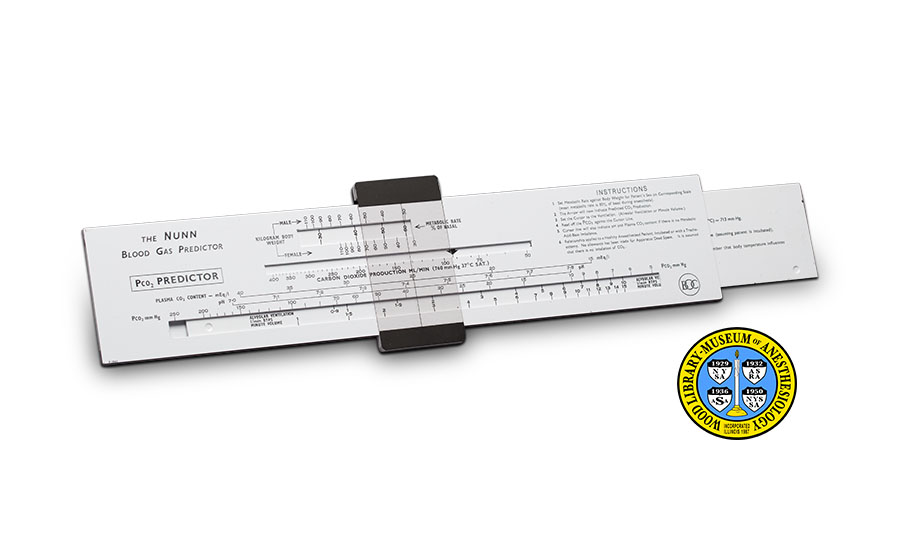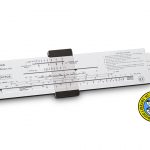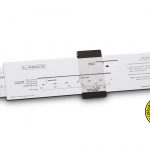Nunn Blood Gas Calculator
Because anesthesia affects the body's ability to breathe normally, anesthesiologists monitor the patient's respiration. British anesthesiologist and educator, John Francis Nunn, M.B., Ph.D., FRCS, FFARCS, FFARACS (Hon.), FFARCSI (Hon.), (born 1925), has received numerous awards and honors for his innovative and fruitful research. Among his contributions to the specialty is his classic textbook, Applied Respiratory Physiology.
In 1960, Nunn described the use of a special graph, called a nomogram, to predict the partial pressure of carbon dioxide in arterial blood during anesthesia. Two years later Nunn introduced his slide rule for predicting the arterial partial pressures both of carbon dioxide (abbreviated PCO2) and of oxygen (abbreviated PO2). This was a quick and inexpensive method of computing predicted carbon dioxide and oxygen levels, and was more accurate than calculations based on clinical observation alone. It did not require drawing a sample of either the patient's blood or expired air, nor the use of equipment for analyzing such samples.
Manufactured by the British Oxygen Company, the slide rule has one scale for ventilation, and separate scales for the body weights and metabolic rates of male and female patients. Three years later, the Radiometer company produced a more complex blood gas calculator. Both of these devices were outmoded by improved blood gas monitors.
Catalog Record: Nunn Blood Gas Calculator Nunn Calculator
Access Key: apoh
Accession No.: 2003-08-04-2 D
Title: The Nunn blood gas predictor / British Oxygen Company.
Author: Nunn, J. F. (John Francis), born 1925.
Corporate Author: British Oxygen Company.
Publisher: London, England : British Oxygen Company, [between 1962 and 1980?].
Physical Description: 1 slide rule : plastics ; .5 x 49 x 7.5 cm.
Subject: Blood Gas Analysis – instrumentation.
Web Link: https://www.woodlibrarymuseum.org/museum/item/1057/nunn-blood-gas-calculator
Note Type: General
Notes: The first year in the date range is based on the date of Nunn’s published description, and that of the instruction manual in the collection of the Harry Daly Museum. The second year in the date range is based on a literature search; the object is likely to have been made somewhat earlier.
The front of the object is considered that side on which both the name of the object and the name of the manufacturer appear; this is the side which is used to calculate PCO2.
The width given in the short description is the maximum extension of the rule, from either side of the sleeve, at which any two numbers on any two scales will aliign. When the rule is fully inserted in the sleeve, the width is approximately 29 centimeters, and approximately 1 centimeter of the rule extends beyond the sleeve.
Note Type: With
Notes: Cardboard case consists of two telescoping parts; The case measures 8 x 29.75 x 2 centimeters; It is marked on the front: “[BOC corporate logo] [new line] THE NUNN [new line] BLOOD GAS CALCULATOR”.
Note Type: Citation
Notes: John Francis Nunn, M.D., Ph.D., F.F.A.R.C.s. [We Salute]. Anest Analg. November/December, 1969;48(6):1024-1025.
Note Type: Citation
Notes: Cooper EA, Smith H. Indirect estimation of arterial pCO2. Anaesthesia. October, 1961;16(4):445-460.
Note Type: Citation
Notes: https://ehive.com/collections/4493/objects/152212/blood-gas-predictor. Accessed December 9, 2016.
Note Type: Citation
Notes: Fink BR. ASA award: John F. Nunn. Anesthesiology. October, 1991;75(4):560-562.
Note Type: Citation
Notes: McIntyre JW, Drummond G. Some observations on the use of the Nunn blood gas predictor. Can Anaesth Soc J. May, 1964;11(3):313-317.
Note Type: Citation
Notes: Nunn JF. The accuracy of the measurement of blood PCO2 by the interpolation technique. In: Woolmer RF, Parkinson J, eds. A Symposium on pH and Blood Gas Measurement. London: Churchill, 1959:60-80.
Note Type: Citation
Notes: Nunn JF. Prediction of carbon dioxide tension during anaesthesia. Anaesthesia. April, 1960;15(2):123-133.
Note Type: Citation
Notes: Nunn JF. Predictors for oxygen and carbon dioxide levels during anaesthesia. Anaesthesia. April, 1962;17(2):182-194.
Note Type: Citation
Notes: Nunn JF. Applied Respiratory Physiology, 2nd ed. London: Butterworths, 1977.
Note Type: Physical Description
Notes: One slide rule; This consists of three parts: an exterior sleeve, made of white plastic, an interior rule made of white plastic, and a transparent plastic slide; The sleeve measures approximately 1 centimeter in height, 28 centimeters in width and 5.75 centimeters in depth; The front panel of the sleeve is that used to calculate PCO2 (arterial partial pressure of carbon dioxide); This side is marked with four scales: “Kilogram Body Weight” (male and female), “Carbon Dioxide Production”, “Plasma CO2 Content”, and PCO2; On the left, from top to bottom, the front is marked (in part): “THE NUNN [new line] BLOOD GAS PREDICTOR [new line] PCO2 PREDICTOR”; Roughly in the center, the front is marked “CARBON DIOXIDE PRODUCTION ML/MIN (760 mm Hg 37 [degrees symbol] C SAT”; On the right, the front is printed with instructions for use; The front lower right corner is marked with the “BOC” logo;
The back panel of the sleeve is used to predict PO2 (arterial partial pressure of oxygen); This side has two scales: “Inspired Oxygen” and “Haemoglobin Saturation %”; At the upper left it is marked: “PO2 PREDICTOR”; Instructions for use are printed on the right; In the lower right corner it is marked: “THE BRITISH OXYGEN COMPANY, LTD.”
When closed, that is with the rule fully inserted in the sleeve, the rule measures approximately 29 centimeters wide and 4.5 centimeters deep; When squared at either end with the sleeve, the slide extends 1 centimeter beyond the sleeve at the opposite end; The front of the rule is marked with two scales; The front is marked in the upper left corner: “BLUNDELL RULES LTD. [new line] WEYMOUTH [new line] P.1843”; The front lower left is marked “ALVEOLAR VENTILATION [new line] 1/min. BTPS [new line] MINUTE VOLUME”; The front upper right is marked: “DESIGN ASSUMPTIONS”; The front lower right is marked “ALVEOLAR VENTILATION [new line] 1/min. BTPS [new line] MINUTE VOLUME”; The back of the rule is marked with three scales; At the upper left the back is marked: “DESIGN ASSUMPTIONS” and at the lower left it is marked: “CORRECTIONS”;
The slide measures .5 centimeters in height, 3.75 centimeters in width and 7 centimeters in depth; The end caps of the slide are made of black and white plastic, while the center panels on the front and back are transparent; The front side of the slide is marked with a single, vertical line down the center; The back side of the slide is marked “ALVEOLAR-ARTERIAL [new line] PO2 DIFFERENCE”.
Note Type: Reproduction
Notes: Photographed by Mr. Steve Donisch, November 14, 2016.
Note Type: Acquisition
Notes: Gift of Robert F. Finegan, M.D.
Note Type: Historical
Notes: Anesthesia affects the body’s ability to breathe normally, which can cause changes in the patient’s blood chemistry.
Anesthesiologists monitor the gases in the patient’s breath and blood. British anesthesiologist and educator, John Francis Nunn, M.B., Ph.D., F.F.A.R.C.S. (born 1925), has received numerous awards and honors for his innovative and fruitful research. Among his contributions to the specialty is his classic textbook, Applied Respiratory Physiology.
In 1954 and 1955, American physiologist Edward P. Radford, Jr., M.D., described the use of a nomogram (a two dimensional graph for computing mathematical functions) for the purpose of calculating patient needs during artificial respiration. In 1960, Nunn described the use of Radford’s nomogram to predict the partial pressure of carbon dioxide in arterial blood (abbreviated PCO2) during anesthesia. Two years later Nunn introduced his slide rule for predicting the arterial concentrations of both carbon dioxide (PCO2) and oxygen (PO2).
This was a quick and inexpensive method, and was more accurate than clinical observation alone. It did not require drawing a sample of either the patient’s blood or expired air, nor the use of equipment for analyzing the samples. The slide rule has one scale for ventilation, and separate scales for the body weights and metabolic rates of male and female patients.
The device was produced by the British Oxygen Company, a manufacturer of anesthetic gases and equipment. An example in the collection of the Harry Daly Museum, in Sydney, Australia, is accompanied by an instruction manual that is dated 1962. The Daly Museum’s description of their example states that it was used by the donor from 1968 to 1970. In 1967, the Danish company, Radiometer, produced a blood gas calculator that was designed by John W. Severinghaus (born 1922.) From the 1960s to the 1980s, equipment that could continuously monitor blood oxygenation became increasingly common. These were replaced, in turn, by transcutaneous pulse oximeters, which measure oxygen saturation (SpO2) rather than PO2.
Note Type: Publication
Notes: Nunn JF. The undressing of pH. Lancet. 1962; 1(2):803.
Note Type: Publication
Notes: Radford EP, Ferris BG, Kriete BC. Clinical use of a nomogram to estimate proper ventilation during artificial respiration. NEJM. November 23, 1954;251(22):877-884.
Note Type: Publication
Notes:Radford EP. Ventilation standards for use in artificial respiration. J Appl Physiol. January, 1955;7(4):451-460.
Note Type: Exhibition
Notes: Selected for the WLM website.



